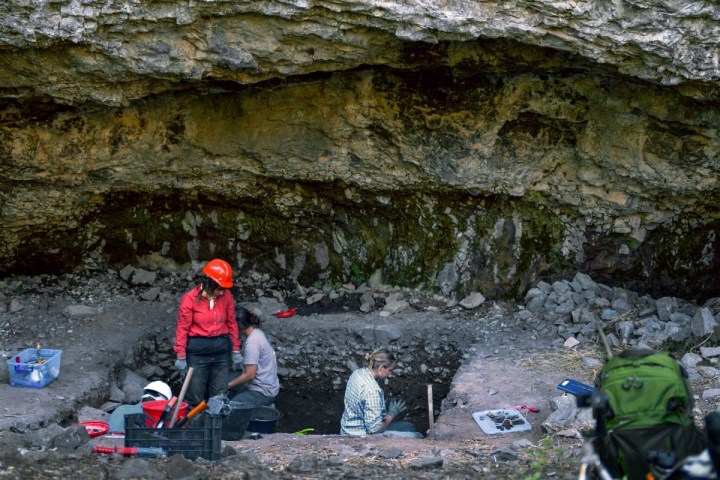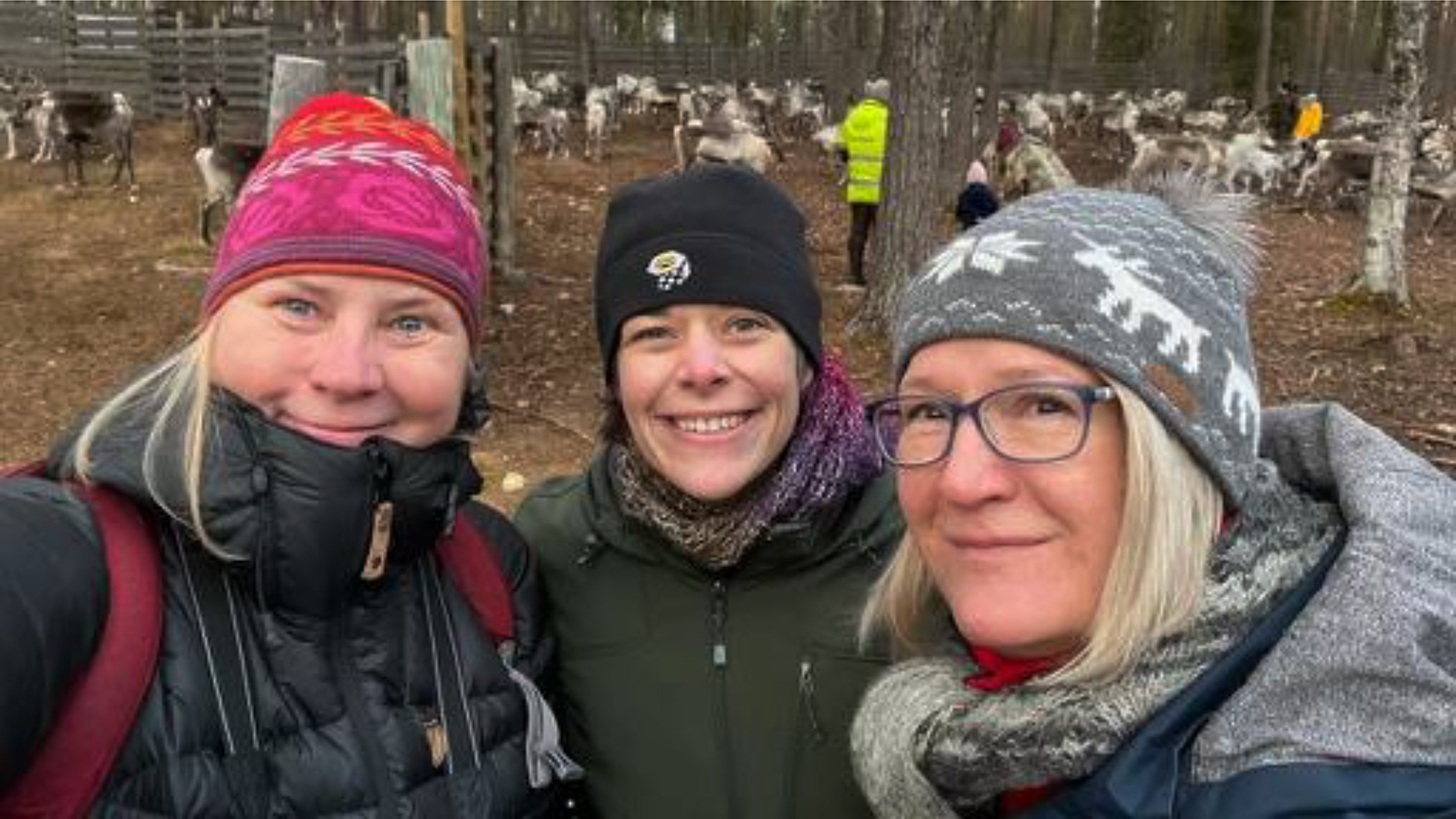BONES TO PICK
Paleo myth clubbed on the head – ‘man the hunter, woman the gatherer’ is just not true

It is a Paleo fantasy that only men hunted, created art and made stone tools, while the women merely gathered tubers and berries while feeding their babies. Women could and did hunt because gender roles are a modern invention.
We are left with the images of the caveman hitting a woman over the head and dragging her back into the cave as his property. Or, when overtly sexist men are described as “Neanderthals” in the media.
These ideas are entrenched in anthropology and archaeology where Pleistocene men are depicted as the protagonists of the images, and hunting – specifically male-only hunting – is celebrated as the behaviour that differentiates humans from the other primates.
This view of the past is a product of long-held assumptions that men are physically superior to women in most ways, never rendered infirm by their reproduction, and therefore natural hunters.
Women are not weak, nor were they in the past.
In two research papers in the American Anthropologist, Sarah Lacy, assistant professor of anthropology, at the University of Delaware and Cara Ocobock, assistant professor of anthropology at the University of Notre Dame challenge the long-held belief about the sexual division of labour in Palaeolithic times (from 2.5 million years ago to 10,000).
They argue that not only are women well suited to endurance activities like hunting, but there is little to no evidence to support that they were not hunting during the Palaeolithic era.
The idea of a deep evolutionary history of male and female social roles is bogus!
In fact females are better suited for long endurance activities, despite science continually trying to pull females out of the evolutionary course of events.
“Much of the story of human evolution has been by and from the perspective of men. And in many ways, these researchers – then and often now – look at the present world, see sexual division of labour and men in more powerful positions. They superimpose the current cultural context onto a past one, without any actual evidence to support that,” says Ocobock.
“The idea of a deep evolutionary history of male and female social roles is bogus!
“Men are not evolved for hunting, just as women are not evolved for gathering or domestic duties. Descriptions of ancient humans as developing hunters who used their increased carnivory and sophisticated tools to spread across the world includes all ancient humans – not just the males,” says Lacy.
Ocobock explains further: “Our reconstructions of the past are largely based on this idea that males are physically superior to females, and because of this they must have done all the ‘physical tasks’ such as hunting. Turns out, females are physiologically better suited for tasks like persistence hunting.”
Oestrogen helps one to run for longer periods without getting as tired or necessarily needing to refuel as regularly.
In the paper looking at the physiological evidence, they write: “[We] found females and males performed similarly during 42km events, but females outperformed males in running events greater than 90km. Females were able to maintain a higher running speed throughout and to perform at a higher percentage of their maximal oxygen capacity relative to males.”
Males reach the point of fatigue faster for both endurance and resistance exercise.
“Overall, oestrogen – through several mechanisms – leads to a greater amount of fat being used as a metabolic substrate to fuel activity. Fat has more calories per gram than either carbohydrates or protein, so you get more bang for your buck.
“Fat also takes longer to metabolise which can lead to a longer, more sustained and consistent level of energy production. Being able to burn more fats during exercise not only protects muscle. After long, intense exercise the body can – though not always – start to break down muscle, but it also appears to delay fatigue. This means that oestrogen helps one to run for longer periods without getting as tired or necessarily needing to refuel as regularly.
“It also appears that oestrogen has a protective effect during and after exercise, meaning that cells and tissue in a heavier oestrogen environment do not experience the same level of damage during the stress that comes about from exercise. Meaning those with more oestrogen are less harmed during exercise and are able to recover faster,” says Ocobock.

Professor Cara Ocobock (middle) during field work in Finland, with colleagues Minna Turunen (left) and Päivi Soppela. (Photo: Minna Turunen)
The hunting mothers? Yes
Northeast Asian Ainu women hunted large game with the help of dogs. Female Martu of Australia provide more consistent meat production than males.
The literature showed that 79% of recent forager cultures’ entries in a database contain descriptions of women hunting. Also, it was mostly intentional hunting documented (87% of cultures with descriptions of female hunting), not opportunistic. Ethnographic data has to be interpreted without bias.
The point is that the female body is not weak, nor is she “weak or incapable” when she breastfeeds.
“It could very well be the supposed burden of pregnancy and childrearing in combination with high degrees of physical activity (hunting, gathering, tool making, etc) that have shaped the suite of features giving females an endurance advantage over males.
“A female’s total energy expenditure increases throughout pregnancy, with an additional 500 kilocalories per day burned in the third trimester. This metabolic cost increases to more than 600 kcal/day throughout lactation. During this time, females, then and now, would still complete their regular tasks and evade predators (at least in our evolutionary past) in addition to gestating, birthing, feeding and caring for offspring, and potentially facing resource-limiting and difficult environmental conditions.
Some women of the Agta of the Philippines hunt while pregnant, lactating, and menstruating and show no decrease in their hunting efficacy, nor increase in child mortality.
“In essence, females with offspring take part in an endurance event that spans years, and their bodies both anticipate this and are able to adjust quickly when the pregnancy hormonal milieu signals its beginning. It should be no surprise females have a greater endurance capacity and durability because the very survival of our species would have depended upon it. Therefore, many pregnancy adaptations in humans are evolutionarily advantageous, not a handicap or a tradeoff, as they are often portrayed,” according to the paper.
Women’s experiences hunting among the Agta of the Philippines are particularly vital for consideration when presented with the arguments for why women would not hunt in the Palaeolithic era: that they need to breastfeed frequently and carry children, and they regularly bleed and smell via menstruation.
Agta women and men spend equal amounts of time hunting. Female hunters with children see no negative impact on their hunting success or child mortality and females hunt while menstruating and carrying nursing infants, they explain.
“Even if women took breaks from hunting around childbirth, it would not rule them out for their lifetimes. Some women of the Agta of the Philippines hunt while pregnant, lactating, and menstruating and show no decrease in their hunting efficacy, nor increase in child mortality.
Read more in Daily Maverick: Siberian caves provide genetic insights into Neanderthal social organisation
“It is a modern construct to limit women to a domestic sphere around the hearth, especially when we are talking about ancient hominins living in small groups. Deaths, seasonal fluctuations in the availability of food, mate swapping could all leave a group with fewer males than needed if only males could hunt – are the females going to starve to maintain strict social roles?
“No, these groups needed to be flexible in their subsistence strategies to stay alive and we see this story written in the bones of these people. Everyone pulled their weight and they have the traumas to prove it,” says Lacy.
Stone tools, diet and bones
There is no actual evidence of different tool types being associated with one gender in the Palaeolithic. The first example of using genetics to identify a maker or user of a deer-tooth pendant in the Upper Palaeolithic found the owner to be female. Dental wear in Neanderthals, which is assumed to be associated with leather processing, is equally present in all sexes.
The association of hunting with masculinity also drives a fixation with eating meat. The belief that ancient people ate a nearly carnivorous diet and the association of hunting with masculine behaviour reinforce one another in constructing a view of the past that focuses on men and fetishises hunting and meat-eating as a defining feature of human evolution.
Read more in Daily Maverick: Secrets in the genes – how ancient DNA sheds light on social changes in Africa 50,000 years ago
Neither belief – that ancient humans ate a carnivorous diet or hunting was a male-only behaviour – are well supported.
Every known, fairly complete Neanderthal over the age of 25 has at least one healed broken bone. There is no sexed pattern to these traumas, and the researchers infer that everyone is doing similar trauma-inducing activities over the life course, one of which could be ambush hunting.
They could also not see sex differences in arthritis from repetitive activities among Neanderthals.
“The long-standing idea that hunting is what led to the evolution of our uniquely human suite of traits, and that it was men doing that hunting, therefore evolution really only acted on males and females were mere passive beneficiaries is absurd. It is not grounded in an ounce of evidence. Women need to be included in reconstructions of our past as the critical contributors they were,” says Ocobock. DM






















 Become an Insider
Become an Insider
Social Science has long held that gender constructs are just that: social constructs, and more specifically, religious constructions. Now we have evidence supporting this meta-narrative from Palaeolithic archaeology.
So if gender roles are entirely socially constructed how can someone be said to be ‘in the wrong body’?
Interesting to look at Bushman culture – Africa’s most ancient hunter-gatherer society. It was mostly men who hunted and women who gathered, although women did occasionally join the hunt. More commonly women would accompany the hunt to help process and transport the meat. It should be noted, though, that bushmen society was not patriarchal, very egalitarian and democratic in fact. There was a form of marriage, but not strongly binding. Further north, the Forest people (“pygmies”) hunted together. Actually the key part of a marriage ceremony was a man and a woman making a hunting net together.
Thanks for the really interesting article.